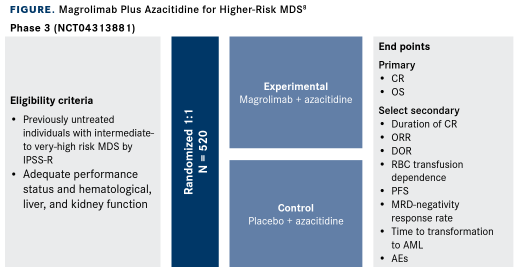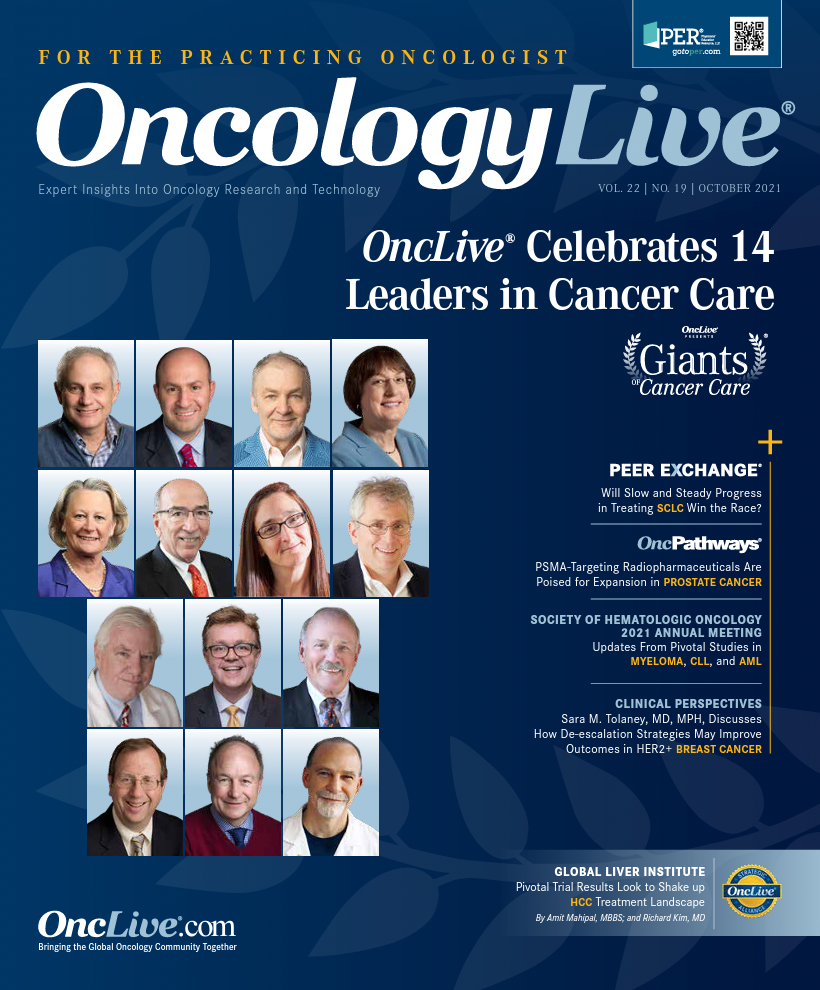Publication
Article
Oncology Live®
Investigators Aim to Fill Unmet Need of Intermediate- to High-Risk MDS With ENHANCE Trial
Author(s):
The initiation of the phase 3 ENHANCE trial looks to build on the generally early response to azacitidine with the addition of magrolimab, a first-in-class monoclonal antibody, for patients with intermediate-, high-, and very high–risk myelodysplastic syndrome.
Eytan M. Stein, MD

Standard-of-care options for patients with intermediate-, high-, and very high–risk myelodysplastic syndrome (MDS) have plateaued in their efficacy, leading investigators to seek alternative novel therapies. The initiation of the phase 3 ENHANCE trial (NCT04313881) looks to build on the generally early response to azacitidine with the addition of magrolimab, a first-in-class monoclonal antibody.1
“There are only 2 treatments available [for these patients],” said Eytan M. Stein, MD, a hematologic oncologist at Memorial Sloan Kettering Cancer Center in New York, New York, in an interview with OncologyLive®. “These options are essentially 2 sides of the same coin. They are both hypomethylating agents; one is azacitidine [Vidaza] and the other is decitabine [Dacogen].”
Azacitidine was approved for all types of MDS in May 2004 based on results of the phase 3 Cancer and Leukemia Group B 9221 study in which the agent elicited a 16.2% response (n = 16/99) compared with no response with placebo (n = 0/92); response rates in similar single-arm studies ranged from 11.8% to 18.8%.2 Similar results were observed to support the FDA approval of decitabine in 2006; the response rate was 21% among 56 evaluable patients treated with the agent vs 0% in the supportive care arm (n = 89).3
“We know from clinical studies that were done about a decade ago that they’re better than doing nothing, which is what we had before these treatments,” Stein said. “But they’re certainly not good enough. The remission rate is in the range of 30% to 40%, [and] survival is somewhat limited. For this patient population, another key factor is that even in the patients who do respond to these drugs, they typically stop working after a year or two. The duration of response [DOR] is not particularly long. There’s a real need for new agents for MDS.”
ENHANCE will evaluate the efficacy of magrolimab in combination with azacitidine, compared with azacitidine plus placebo in previously untreated participants with intermediate-, high-, or very high–risk MDS.1 Preclinical models have shown synergistic effects of combining hypomethylating agents with immune checkpoint inhibitors, and investigators have hypothesized that the combination may overcome resistance mechanisms that arise with hypomethylating agents alone.4
Magrolimab blocks CD47, a key “do not eat me” signal that is often overexpressed on tumor cells. The binding of magrolimab to CD47 induces potent macrophage- mediated phagocytosis of tumor cells. Azacitidine synergizes with magrolimab by increasing expression of prophagocytic “eat me” signals.5-7
“There was a lot of good preclinical science that was done primarily in laboratory work by Ravi Majeti MD, PhD, at Stanford [University in California],” Stein noted. “This [preclinical work] showed that by giving an anti-CD47 antibody, you can get this immunologic approach where you can eradicate the MDS cells, the bad cells, that are causing the problem. The [inhibition of the] ‘do not eat me signal’ allows macrophages to basically recognize the malignant MDS cells, which then allows them to be eradicated through phagocytosis.”
Initial Safety and Efficacy Data of Magrolimab + Azacitidine
Investigators examined the combination of magrolimab and azacitidine in patients with hematological malignancies in a phase 1b trial (NCT03248479). A total of 39 patients with MDS have been treated with the combination. The median age of this cohort was 70 years (range, 47-80) and 13% of patients harbored a TP53 mutation.7
Magrolimab was given via a priming/intrapatient dose-escalation regimen of 1 to 30 mg/kg once a week for the first 2 cycles, then once every 2 weeks in cycles 3 and beyond. Azacitidine was administered at a dose of 75 mg/m2 on days 1 to 7.
Among 33 patients evaluable for efficacy, the objective response rate (ORR) was 91% with 42% of responders achieving complete remission (CR). Several responses deepened over time; patients with at least a 6-month follow-up achieved a CR rate of 56%. The median overall survival (OS) has not been reached (95% CI, 1.4-18.3), and the 6-month estimated OS rate is 100%.7
Cytogenetic CRs were observed in 35% of efficacy-evaluable patients, with 91% of responding patients having a continuing response at 6 months. The median time to initial response was 1.9 months. Minimal residual disease negativity by multi- parameter flow cytometry was reported in 22% of patients with CR, CR with incomplete hematologic recovery, or marrow CR.7
Regarding safety, the most common adverse effects (AEs) of any grade were anemia (44%), fatigue (18%), infusion reaction (18%), and neutropenia (8%). No patients in the MDS cohort discontinued treatment because of an AE, and no treatment-related febrile neutropenia was seen by investigators.7
The median decrease in hemoglobin with the first dose of magrolimab plus azacitidine was 0.4 g/dL. Investigators noted that the combination had a similar safety profile compared with azacitidine monotherapy.7
“Magrolimab actually possesses a fairly good toxicity profile; it doesn’t have many significant AEs,” Stein said. “The most significant AE is that patients can experience an on-target anemia, which can be pretty dramatic at the onset. Also, in some patients, you can see the hemoglobin dropped by 2 to 3 grams.”
AEs, adverse effects; AML, acute myeloid leukemia; CR, complete remission; DOR, duration of response; EFS, event-free survival; IPSS-R, Revised International Prognostic Scoring System; MDS, myelodysplastic syndrome; MRD, minimal residual disease; ORR, objective response rate; OS, overall survival; PFS, progression-free survival; RBC, red blood cell.

Details of the ENHANCE Trial
The phase 3 trial will enroll approximately 520 previously untreated adult patients with intermediate-, high-, very high–risk MDS by Revised International Prognostic Scoring System in the United States, Europe, Asia, and Australia [Figure8]. To be eligible for the study, patients must have adequate performance status and hematological, liver, and kidney function. Patients will be evenly randomized to receive either magrolimab plus azacitidine or placebo plus azacitidine.1,8
Ineligible patients include those with active hepatitis B, C, and/or HIV after testing at screening or in their medical history. Patients previously treated with anti-CD47 or signal-regulatory protein α-targeting agents are not eligible for the trial. Patients with clinical suspicion of active central nervous system involvement or those who are pregnant or actively breastfeeding also will be excluded.8
Patients in the trial cannot have undergone any prior antileukemic therapy for treatment of intermediate-, high-, or very high–risk MDS. Patients with contraindications to azacitidine will be excluded, as well as those who have immediate eligibility for allogenic stem cell transplant with an available donor, as determined by the investigators.8
Patients in the experimental arm will receive a 1 mg/kg dose of magrolimab intravenously on days 1 and 4 of cycle 1, followed by 15 mg/kg on day 8, and 30 mg/kg on days 11, 15, and 22. In cycle 2, patients will be given 30 mg/kg of magrolimab on days 1, 8, 15, and 22. In cycle 3 and beyond, 30 mg/kg of magrolimab will be administered every 2 weeks on days 1 and 15.1,8
Stein said that a change in the trial design—treating patients frequently with smaller doses at the start—helped to curb some of the common AEs. “As a result of [this dosing schedule], we believe that is going to help prevent this anemia that you may see,” he said.
In the control arm, placebo to match magrolimab will be administered intravenously. In both arms, azacitidine will be given at 75 mg/m2 on days 1 to 7, or days 1 to 5 and 8 to 9 of each cycle, either subcutaneously or intravenously according to region-specific drug labeling.8
The primary end points of the trial are CR rate and overall survival. Key secondary end points include duration of CR, ORR, DOR, and progression-free survival. The trial is estimated to be completed by February 2025.8
“I believe magrolimab with azacitidine will become the standard of care,” Stein concluded. “If [the data] pan out in this phase 3 trial, it would be the first real immunotherapy/checkpoint inhibitor treatment for a myeloid malignancy. People talk about PD-L1 and PD-1 inhibitors in solid tumors [but] we haven’t had something that really works like that in patients with MDS or acute myeloid leukemia. If this [regimen] does work in the phase 3 setting, it’s a proof of concept that there is an immunologic therapy that you can give that can make outcomes in patients better in this class of diseases.”
References
- Garcia-Manero G, Daver NG, Xu J, et al. Magrolimab + azacitidine versus azacitidine + placebo in untreated higher risk (HR) myelodysplastic syndrome (MDS): the phase 3, randomized, ENHANCE study. J Clin Oncol. 2021;39(suppl 15):TPS7055. doi:10.1200/JCO.2021.39.15_suppl.TPS7055
- Kaminskas E, Farrell AT, Wang YC, Sridhara R, Pazdur R. FDA drug approval summary: azacitidine (5-azacytidine, Vidaza) for injectable suspension. Oncologist. 2005;10(3):176-182. doi:10.1634/theoncologist.10-3-176
- Dacogen. Prescribing information. MGI Pharma Inc; 2006. Accessed September 14, 2021. bit.ly/3lurjlQ
- Takimoto CH, Chao MP, Gibbs C, et al. The macrophage ‘do not eat me’ signal, CD47, is a clinically validated cancer immunotherapy target. Ann Oncol. 2019;30(3):486-489. doi:10.1093/ annonc/mdz006
- Bewersdorf JP, Carraway H, Prebet T. Emerging treatment options for patients with high-risk myelodysplastic syndrome. Ther Adv Hematol. 2020;11:2040620720955006. doi:10.1177/2040620720955006
- Liu J, Wang L, Zhao F, et al. Pre-clinical development of a humanized anti-cd47 antibody with anti-cancer therapeutic potential. PLOS One. 2015;10(9):e0137345. doi:10.1371/journal.pone. e0137345
- Sallman D, Malki MA, Asch A, et al. The first-in-class anti-CD47 antibody magrolimab combined with azacitidine is well-tolerated and effective in MDS patients: phase 1b results. Paper presented at: European Hematology Association 25 Virtual Congress. June 11-October 15, 2020. Accessed August 31, 2021. bit.ly/3CrsgSX
- Magrolimab + azacitidine versus azacitidine + placebo in untreated participants with myelodysplastic syndrome (MDS) (ENHANCE). ClinicalTrials.gov. Updated August 23, 2021. Accessed August 31, 2021. https://clinicaltrials.gov/ct2/ show/NCT04313881




















%20(2)%201-Recovered-Recovered-Recovered-Recovered-Recovered-Recovered-Recovered-Recovered-Recovered-Recovered-Recovered-Recovered-Recovered-Recovered-Recovered-Recovered-Recovered.jpg?fit=crop&auto=format)
%20(2)%201-Recovered-Recovered-Recovered-Recovered-Recovered-Recovered-Recovered-Recovered-Recovered-Recovered-Recovered-Recovered-Recovered-Recovered-Recovered-Recovered-Recovered.jpg?fit=crop&auto=format)
